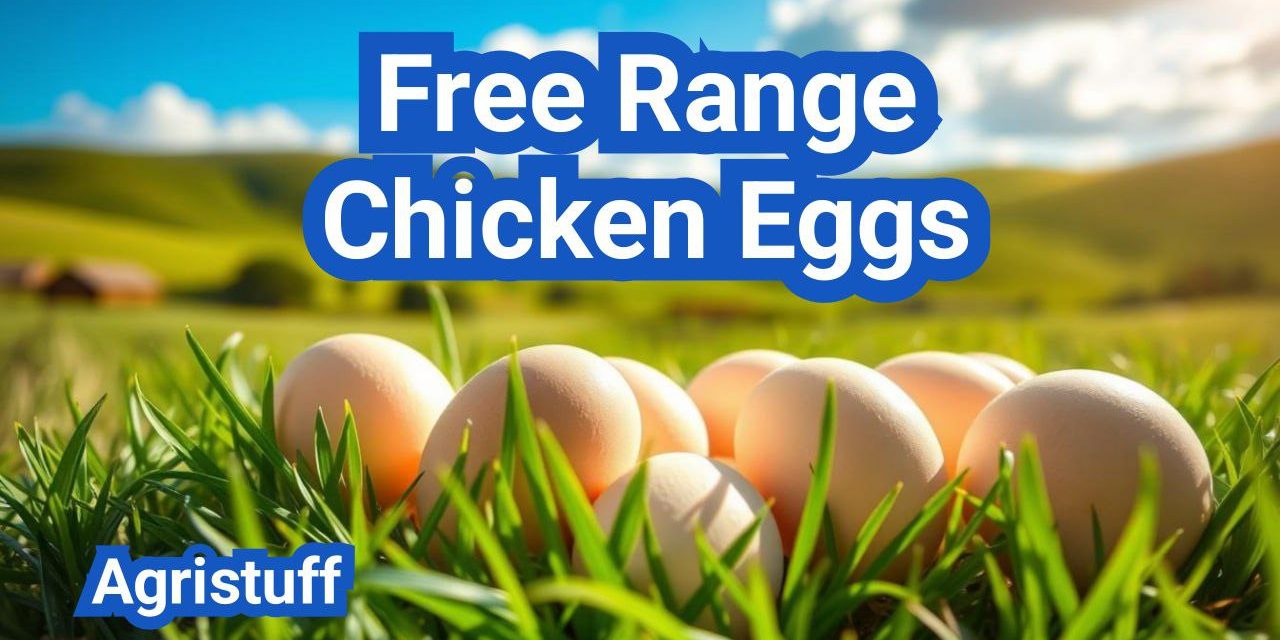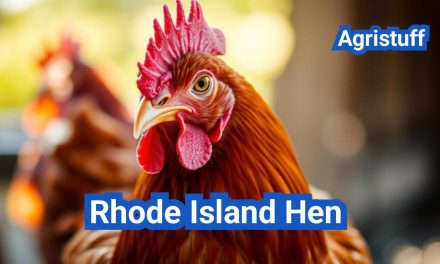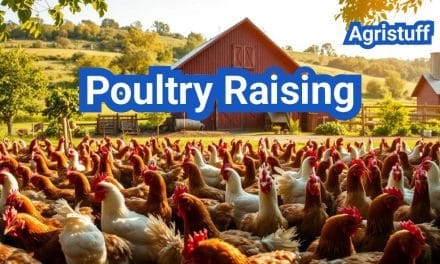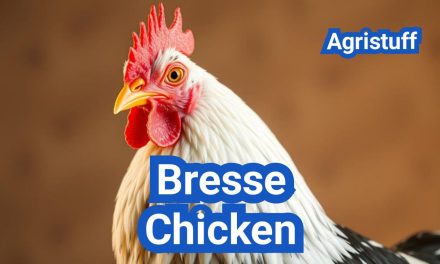The terms “cage-free,” “free range,” and “pasture-raised” describe different methods of egg production, with varying levels of animal welfare standards. According to Medical News Today, these labels are often associated with different levels of hen welfare and environmental impact.
Free range chicken eggs are produced by hens that have access to the outdoors, which can improve their welfare and the quality of the eggs. Understanding the differences between cage-free eggs, pasture-raised eggs, and organic eggs can help consumers make informed choices.
Key Takeaways
- The terms “cage-free,” “free range,” and “pasture-raised” have different implications for hen welfare.
- Free range chicken eggs are produced by hens with outdoor access.
- The production methods of free range eggs can impact egg quality and nutritional content.
- Consumers should understand the differences between various egg labels.
- Choosing the right type of eggs can support animal welfare and sustainability.
What Are Free Range Chicken Eggs?
The term ‘free range chicken eggs’ refers to eggs produced by hens that have access to the outdoors, but what does this really mean? Understanding the nuances behind free range chicken eggs is essential for consumers who prioritize animal welfare and egg quality.
Official Definitions and Standards
The definition of free range chicken eggs can vary depending on the certifying organization. For instance, the United Egg Producers (UEP) Certified cage-free mark defines cage-free as hens having at least 1 square foot of floor space each. In contrast, the American Humane Certified program requires 1.25 square feet per hen. These standards highlight the complexity of defining free range and the need for consumers to be aware of the different certifications.
Some key aspects of official definitions include:
- Space per hen: Minimum space requirements vary among certifying organizations.
- Access to outdoors: True free range systems provide hens with outdoor access, though the extent of this access can differ.
- Certification processes: Various organizations offer certifications based on different criteria, making it crucial for consumers to understand these differences.
Free Range vs. Other Egg Production Systems
Free range egg production is often compared to other systems such as cage-free and pasture-raised. While cage-free hens are not confined to cages, they may not necessarily have outdoor access. Pasture-raised hens, on the other hand, are typically raised on pasture with significant outdoor access, potentially offering a more natural environment.
The main differences between these systems are:
- Outdoor access: Free range and pasture-raised systems provide outdoor access, whereas cage-free does not necessarily.
- Space and living conditions: The amount of space and quality of living conditions can vary significantly between these systems.
- Animal welfare: Systems with outdoor access are often considered to offer better animal welfare.
By understanding these differences, consumers can make more informed choices about the eggs they purchase, aligning with their values on animal welfare and sustainability.
The Evolution of Free Range Egg Farming

From traditional backyard flocks to modern commercial operations, free range chicken layer production has come a long way. Historically, chicken keeping practices were more diverse, with hens having access to outdoor spaces.
Traditional Chicken Keeping Practices
In the past, chickens were often kept in backyards or small farms where they could roam freely. This traditional method allowed chickens to forage for insects, seeds, and plants, contributing to a diverse diet.
Benefits of Traditional Practices
- Improved animal welfare due to more space and natural behavior
- Diverse diet from foraging, potentially enhancing egg nutritional quality
- Lower initial investment compared to modern intensive systems
Modern Free Range Systems Development
Modern free range egg production has evolved to incorporate better welfare standards and environmental sustainability. Today’s free range systems often feature:
| Feature | Description | Benefit |
|---|---|---|
| Outdoor Access | Chickens have access to outdoor areas | Improved welfare and natural behavior |
| Rotational Systems | Outdoor areas are rotated to maintain land health | Environmental sustainability |
| Enhanced Shelter | Shelter designs prioritize chicken comfort and safety | Better protection from predators and elements |
These modern systems aim to balance the needs of both the chickens and the environment, creating a more sustainable and humane egg production process.
Nutritional Benefits of Free Range Chicken Eggs
Research has shown that free range chicken eggs often possess a more favorable nutritional profile compared to eggs from caged hens. The difference is largely attributed to the living conditions and diet of the hens.
Enhanced Vitamin and Mineral Content
Free range eggs are known for their enhanced vitamin and mineral content. Studies have indicated that these eggs tend to have higher levels of vitamins A and E, as well as minerals like iron and zinc.
| Nutrient | Free Range Eggs | Caged Eggs |
|---|---|---|
| Vitamin A | Higher | Lower |
| Vitamin E | Higher | Lower |
| Iron | Higher | Lower |
| Zinc | Higher | Lower |
Protein Quality and Amino Acid Profile
The protein quality in free range eggs is considered superior due to the diverse diet of free range hens. These hens forage for a variety of foods, including insects and plants, which contributes to a more balanced amino acid profile.
“The nutritional quality of eggs is directly related to the nutrition and living conditions of the hens. Free range hens produce eggs that are not only richer in nutrients but also have a better fatty acid profile.”
Healthy Fat Composition
Free range eggs are also praised for their healthy fat composition. They typically contain higher levels of omega-3 fatty acids, which are essential for heart health and brain function.
- Higher omega-3 fatty acids
- Better balance of saturated and unsaturated fats
- More conjugated linoleic acid (CLA)
In conclusion, the nutritional benefits of free range chicken eggs make them a preferable choice for consumers looking to enhance their diet with high-quality protein and essential nutrients.
Health Advantages of Consuming Free Range Chicken Eggs

Free-range chicken eggs provide a nutritional boost that can contribute to better health outcomes. These eggs are produced under conditions that allow chickens to roam freely, resulting in eggs that are richer in nutrients and lower in harmful substances.
Improved Nutritional Density
One of the significant health advantages of free-range chicken eggs is their improved nutritional density. Eggs from free-range chickens tend to have higher levels of vitamins A and E, omega-3 fatty acids, and antioxidants compared to eggs from caged hens. This enhanced nutritional profile can contribute to better overall health when consumed as part of a balanced diet.
Lower Cholesterol Concerns
Research suggests that eggs from free-range chickens may have a more favorable fatty acid profile, which can help mitigate cholesterol concerns. While eggs are relatively high in cholesterol, the nutritional benefits of free-range eggs, including their higher omega-3 content, can help balance this aspect. Moreover, dietary cholesterol has a limited impact on blood cholesterol levels for most people, making free-range eggs a relatively safe choice.
Reduced Antibiotic Exposure
Free-range chicken eggs are often produced without the use of antibiotics, reducing the risk of antibiotic exposure for consumers. This aspect is particularly important in the context of growing antibiotic resistance. By choosing free-range eggs, consumers can support more sustainable and responsible farming practices that prioritize animal health and welfare.
In summary, incorporating free-range chicken eggs into your diet can offer numerous health advantages, from improved nutritional density to reduced exposure to antibiotics. As consumers become more aware of the benefits of free-range eggs, the demand for these products is likely to continue growing.
Free Range Chicken Eggs vs. Caged Eggs
Understanding the differences between free-range and caged eggs can help consumers make informed decisions about their dietary choices and the ethical implications of their purchases.
Animal Welfare Differences
One of the primary distinctions between free-range and caged eggs lies in the living conditions of the hens. Free-range systems prioritize animal welfare by providing hens with access to outdoor spaces, allowing them to engage in natural behaviors such as foraging and roaming.
Key benefits for hens in free-range systems include:
- More space to move and exercise
- Opportunity to exhibit natural behaviors
- Better health due to reduced stress and increased activity
“The welfare of the hens is directly linked to the quality of the eggs they produce. Free-range systems promote a healthier and more natural environment for the hens.” –
Animal Welfare Expert
Nutritional Comparison
Research has shown that free-range eggs often have a more favorable nutritional profile compared to caged eggs. The varied diet and increased activity of free-range hens contribute to eggs that are richer in certain nutrients.
| Nutrient | Free-Range Eggs | Caged Eggs |
|---|---|---|
| Omega-3 Fatty Acids | Higher | Lower |
| Vitamin D | Higher | Lower |
| Protein Quality | Better | Good |
Environmental Impact Assessment
The environmental impact of egg production is another critical factor when comparing free-range and caged systems. Free-range systems can have a lower environmental footprint due to more sustainable farming practices.
Environmental benefits of free-range egg production include:
- Reduced carbon footprint
- More sustainable land use
- Potential for regenerative agriculture practices
In conclusion, the choice between free-range and caged eggs involves considerations of animal welfare, nutritional quality, and environmental sustainability. By understanding these differences, consumers can make choices that align with their values and dietary preferences.
Free Range Eggs vs. Store-Bought Conventional Eggs

Free range eggs and store-bought conventional eggs differ in several key aspects that impact consumer choice. The differences are not just limited to the production methods but also extend to the characteristics of the eggs themselves.
Taste and Appearance Differences
One of the most noticeable differences between free range eggs and conventional eggs is their taste and appearance. Free range eggs often have a richer, more vibrant yolk color and a more robust flavor profile compared to conventional eggs. This is due to the diverse diet of free range hens, which includes foraging for insects, seeds, and plants.
The yolks of free range eggs are typically more orange in color, indicating a higher content of beta-carotene and other carotenoids. In contrast, conventional eggs may have paler yolks due to the hens being fed a standardized diet.
- Rich Yolk Color: Free range eggs often have a deeper orange yolk.
- Flavor Profile: Free range eggs are known for their richer, more complex taste.
Price Point Analysis
The price of free range eggs is generally higher than that of conventional store-bought eggs. This price difference is largely due to the higher production costs associated with free range egg farming, including providing hens with more space and a more natural environment.
Consumers are willing to pay a premium for free range eggs due to their perceived health benefits and improved animal welfare. However, the price difference can be a deterrent for some consumers.
- Higher production costs for free range eggs.
- Consumer willingness to pay more for perceived benefits.
Decoding Marketing Claims
When shopping for eggs, consumers are often faced with a myriad of marketing claims such as “cage-free,” “free range,” and “pasture-raised.” Understanding these labels is crucial for making informed purchasing decisions.
While “cage-free” means hens are not kept in cages, it doesn’t necessarily mean they have access to the outdoors. “Free range” implies that hens have some access to the outdoors, but the extent of this access can vary. “Pasture-raised” typically means hens are raised on pasture with significant outdoor access.
Consumers should be aware of these definitions to ensure they are purchasing eggs that align with their values and expectations.
- Cage-Free: Hens are not in cages, but outdoor access is not guaranteed.
- Free Range: Hens have some outdoor access, but the extent varies.
- Pasture-Raised: Hens are raised on pasture with significant outdoor access.
Understanding Egg Labeling Systems

As consumers become more conscious of their food choices, egg labeling systems play a vital role in transparency. These systems help consumers make informed decisions by providing information about the production methods used to produce eggs.
Cage-Free Certification Requirements
Cage-free certification is one of the most common labeling systems for eggs. To be considered cage-free, hens must be housed in environments where they have the freedom to move and engage in natural behaviors. The United Egg Producers (UEP) Certified program is a prominent certification for cage-free eggs, ensuring that hens are raised in improved conditions.
The UEP Certified program has specific requirements, including:
- A minimum of 1.0 square feet per hen indoors
- Access to perches, nest boxes, and scratch areas
- Provisions for hen health and welfare monitoring
Pasture-Raised Standards
Pasture-raised eggs come from hens that have been raised on pasture, where they can forage for grasses, bugs, and other natural food sources. The standards for pasture-raised eggs can vary, but they generally require hens to have access to the outdoors.
| Certification Program | Outdoor Access Requirement | Minimum Outdoor Space per Hen |
|---|---|---|
| Certified Humane Pasture-Raised | Yes | 2 square feet |
| American Pasture-Raised Association (APRA) | Yes | Varies by program |
Organic Certification Process
The USDA Organic certification is a rigorous process that ensures eggs are produced without the use of synthetic fertilizers, pesticides, or genetically engineered organisms (GEOs). Organic hens must have access to the outdoors and be fed organic feed.
To achieve organic certification, producers must undergo a thorough inspection process, maintain detailed records, and comply with USDA Organic regulations. The certification process involves:
- Application and initial inspection
- Annual inspections to ensure compliance
- Record-keeping of feed, health practices, and outdoor access
Understanding these egg labeling systems empowers consumers to make choices that align with their values and dietary preferences. By choosing eggs with labels that reflect higher welfare standards or more natural production methods, consumers can support more sustainable and humane farming practices.
Setting Up a Free Range Chicken Environment
Creating a safe and healthy environment for free-range chickens requires a comprehensive approach that includes adequate space, proper fencing, and suitable shelter. This environment is crucial for the welfare of the chickens and the overall success of the free-range egg production operation.
Space and Land Requirements
The amount of space required for free-range chickens can vary depending on factors such as breed, age, and local regulations. Generally, it’s recommended to provide at least 2-4 square feet of outdoor space per chicken. Adequate space allows chickens to engage in natural behaviors like foraging and exercising, which is essential for their health and well-being.
In addition to outdoor space, the indoor shelter area should provide enough room for chickens to roost comfortably without overcrowding. A general guideline is to allow at least 3-4 square feet per chicken inside the coop.
Fencing and Boundary Considerations
Fencing is a critical component of a free-range chicken environment, serving to protect the chickens from predators and prevent them from escaping. The type and height of fencing will depend on the specific needs of the operation and the types of predators present in the area. Sturdy fencing that extends at least 12 inches below ground can help deter digging predators.
Boundary considerations also involve ensuring that the free-range area is free from toxic plants and other hazards. Regular inspection and maintenance of the fencing and surrounding area are necessary to ensure the chickens’ safety.
Shelter Design for Free Range Flocks
The shelter or coop provides chickens with protection from the elements and predators. A well-designed shelter should be well-ventilated, dry, and draft-free. Proper ventilation is crucial for maintaining air quality and reducing the risk of respiratory problems.
The design should also facilitate easy cleaning and egg collection. Some producers incorporate features like nesting boxes and roosting bars to enhance the welfare and productivity of the flock.
Best Chicken Breeds for Free Range Egg Production

The success of free-range egg farming begins with identifying the best chicken breeds. Certain chicken breeds are better suited for free-range egg production due to their hardiness, foraging ability, and climate adaptability.
Top Heritage Breeds for Free Ranging
Heritage breeds are known for their robustness and ability to thrive in free-range conditions. Breeds like the Rhode Island Red and Barred Plymouth Rock are popular choices due to their excellent foraging abilities and high egg production.
- Rhode Island Red: Known for their hardiness and prolific egg-laying.
- Barred Plymouth Rock: Friendly, forages well, and produces a high volume of eggs.
- Wyandotte: Cold-hardy and known for its rich, brown eggs.
Productive Modern Layer Varieties
Modern layer varieties have been bred specifically for their egg-laying capabilities. These breeds are often more productive than heritage breeds but may require more intensive care.
| Breed | Egg Production | Climate Adaptability |
|---|---|---|
| Leghorn | High | Warm climates |
| Golden Comet | High | Temperate climates |
| ISA Brown | Very High | Cool climates |
Climate-Adapted Breed Selection
Choosing a breed that is adapted to your local climate is crucial for the success of your free-range egg operation. Some breeds are more tolerant of extreme temperatures than others.
For cold climates, breeds like the Brahma and Chantecler are well-suited due to their cold hardiness. In contrast, breeds like the Leghorn perform well in warmer climates.
By selecting the right breed for your climate and management system, you can optimize egg production and ensure the health and welfare of your flock.
Nutrition and Care for Free Range Laying Hens

Providing optimal nutrition and care for free range laying hens is crucial for their health and productivity. A well-balanced diet, opportunities for natural foraging, and effective water management systems are essential components of their overall care.
Balanced Feed Formulations
A balanced feed formulation is vital for the nutritional well-being of free range laying hens. The feed should contain a mix of proteins, carbohydrates, vitamins, and minerals that cater to their nutritional needs. A typical laying hen diet consists of 16-18% protein, with a balance of essential amino acids like methionine and lysine.
Natural Foraging Supplements
In addition to commercial feed, free range laying hens benefit from natural foraging supplements. Allowing hens to forage on pasture provides them with vitamins, minerals, and antioxidants that may not be present in their regular feed. Pasture management is crucial to ensure that hens have access to fresh, nutritious forage.
Water Management Systems
Effective water management systems are critical for the health of free range laying hens. Ensuring access to clean, fresh water at all times is essential. Watering systems should be designed to minimize waste and prevent contamination.
Health Monitoring Protocols
Regular health monitoring
is necessary to identify any health issues early. This includes checking for signs of illness, injury, or stress, and implementing measures to prevent disease. Regular monitoring also helps in maintaining the overall health and productivity of the flock.
By focusing on balanced feed formulations, natural foraging supplements, water management systems, and health monitoring protocols, farmers can ensure the well-being and productivity of their free range laying hens.
Free Range Chicken Eggs Production Methods

The success of free-range chicken egg production hinges on a combination of daily management, seasonal adjustments, and natural yield maximization techniques. Effective production methods are essential for ensuring the health and productivity of the flock, as well as the quality of the eggs produced.
Daily Management Routines
Daily management is critical in free-range egg production. It involves monitoring the health of the chickens, ensuring they have adequate feed and water, and maintaining the cleanliness of their living environment. Regular checks on the flock’s health can help identify any issues early, reducing the risk of disease.
A typical daily routine may include:
- Inspecting the flock for signs of illness or stress
- Providing fresh water and nutritious feed
- Collecting eggs from the nesting boxes
- Maintaining the cleanliness of the coop and surrounding areas
Seasonal Production Adjustments
Seasonal changes can significantly impact free-range chicken egg production. Farmers must adjust their management practices to accommodate variations in temperature, daylight hours, and potential extreme weather conditions.
| Season | Adjustments |
|---|---|
| Spring | Increase in daylight hours can boost egg production; ensure adequate nutrition to support increased laying. |
| Summer | Provide shade and ensure adequate ventilation to prevent heat stress. |
| Autumn/Fall | Prepare for decreasing daylight hours by adjusting lighting in the coop if necessary. |
| Winter | Ensure the coop is well-insulated and draft-free; consider supplemental lighting to maintain egg production. |
Maximizing Egg Yield Naturally
Maximizing egg yield naturally involves a combination of good nutrition, appropriate lighting, and stress reduction. Providing a balanced diet that includes necessary vitamins and minerals is crucial. Additionally, ensuring that hens have enough space to roam and engage in natural behaviors can reduce stress and promote health.
“The key to successful free-range egg production lies in understanding and meeting the needs of your hens, from nutrition to environmental conditions.”
— Expert in Poultry Farming
By implementing these strategies, farmers can enhance the productivity and health of their flock, leading to higher quality eggs and a more sustainable farming operation.
Predator Protection Strategies for Free Range Flocks

One of the significant challenges faced by free-range chicken farmers is protecting their flocks from various predators. Effective predator protection strategies are crucial for maintaining a healthy and productive egg production system.
Common Predator Identification
Understanding the types of predators that threaten free-range chicken flocks is essential for developing effective protection strategies. Common predators include:
- Foxes
- Coysotes
- Hawks
- Owls
- Raccoons
- Snakes
Identifying the specific predators in your area will help you tailor your protection measures. For instance, if foxes are a common problem, you may need to focus on securing the perimeter of your farm.
Physical Barrier Systems
Implementing physical barriers is a critical component of predator protection. Some effective measures include:
- Fencing: Installing sturdy fencing around the farm or coop area can prevent predators from entering.
- Netting: Covering the top of the enclosure with netting can protect against aerial predators like hawks and owls.
- Hardware cloth: Using hardware cloth instead of chicken wire can prevent predators from chewing through the enclosure.
A well-designed physical barrier system can significantly reduce the risk of predator attacks. The table below summarizes the effectiveness of different barrier types:
| Barrier Type | Effectiveness Against | Cost |
|---|---|---|
| Fencing | Foxes, Coyotes | Moderate |
| Netting | Hawks, Owls | Low |
| Hardware Cloth | Raccoons, Snakes | High |
Guardian Animals and Other Deterrents
In addition to physical barriers, using guardian animals or other deterrents can provide an extra layer of protection. Some popular options include:
- Dogs: Trained guard dogs can effectively deter predators.
- Donkeys: Donkeys are known to be protective of their territory and can guard against predators.
- Motion-activated lights or sprinklers: These can startle predators and deter them from approaching the flock.
By combining these strategies, free-range chicken farmers can significantly reduce the risk of predator attacks and protect their flocks. It’s essential to regularly inspect and maintain these protection measures to ensure their effectiveness.
Egg Collection and Processing Procedures

The quality of free-range eggs is significantly influenced by the methods used in their collection and processing. Efficient egg collection and processing procedures are essential for maintaining egg quality, including timely collection, appropriate cleaning methods, and accurate grading and sorting.
Collection Timing and Frequency
Collecting eggs in a timely manner is crucial to prevent breakage and contamination. The frequency of collection depends on several factors, including the size of the flock, climate conditions, and the design of the free-range area.
Best Practices for Egg Collection:
- Collect eggs at least twice a day, preferably in the morning and afternoon.
- Use clean, dry containers to store collected eggs.
- Handle eggs gently to prevent cracking.
Cleaning Methods for Free Range Eggs
Cleaning eggs is a delicate process that requires careful consideration to maintain egg quality. The method of cleaning can significantly impact the egg’s appearance and safety.
“The cleanliness of eggs is directly related to the health of the flock and the cleanliness of their environment.” – Expert in Poultry Farming
Recommended Cleaning Procedures:
| Cleaning Method | Description | Effectiveness |
|---|---|---|
| Dry Cleaning | Using a dry cloth or brush to remove dirt. | High |
| Wet Cleaning | Washing with water, sometimes with a sanitizing solution. | Moderate |
| Sand or Abrasive Cleaning | Using sand or an abrasive material to remove stubborn dirt. | Low |
Grading and Sorting Techniques
Grading and sorting eggs are critical steps in the processing procedure, ensuring that eggs are categorized based on their quality and size.
Grading Criteria:
- Size: Eggs are sorted into different sizes based on their weight.
- Quality: Eggs are graded based on their appearance, including shell integrity and cleanliness.
- Shape: Irregularly shaped eggs are often sorted out.
By implementing these egg collection and processing procedures, producers can ensure that their free-range eggs meet high standards of quality and safety.
Free Range Egg Safety and Storage
Proper handling and storage of free-range eggs are essential for preserving their nutritional value and safety. Free-range eggs, known for their superior quality and nutritional profile, require specific care to maintain their integrity from the farm to the consumer’s table.
Proper Refrigeration Guidelines
Refrigeration is a critical aspect of egg storage. Free-range eggs should be stored in the refrigerator at a consistent temperature below 40°F (4°C). This helps in slowing down the bacterial growth and maintaining the egg’s quality.
Shelf Life Expectations
The shelf life of free-range eggs can vary depending on several factors, including storage conditions and handling practices. Generally, when stored properly in the refrigerator, eggs can last for several weeks. It’s essential to check the eggs for any visible cracks or dirt before storing them.
Contamination Prevention Measures
Preventing contamination is crucial for maintaining the safety of free-range eggs. This involves ensuring that the eggs are collected regularly, cleaned appropriately (if necessary), and stored in clean environments. Farmers and consumers alike should be aware of the risks of Salmonella and other pathogens.
| Storage Condition | Temperature | Shelf Life |
|---|---|---|
| Refrigerated | Below 40°F (4°C) | Several weeks |
| Room Temperature | 70°F – 75°F (21°C – 24°C) | 1 week |
Ensuring the safety of free-range eggs is a collective responsibility that involves farmers, distributors, and consumers. By following proper refrigeration guidelines, understanding shelf life expectations, and implementing contamination prevention measures, we can enjoy these nutritious eggs while maintaining food safety standards.
Starting Your Own Backyard Free Range Egg Operation
Embarking on a backyard free-range egg operation can be a rewarding venture for those interested in sustainable living. This endeavor not only provides fresh eggs but also contributes to a more self-sufficient lifestyle.
Initial Investment Requirements
The initial investment for a backyard free-range egg operation includes several key components. First, you’ll need to purchase chickens, with the cost varying depending on breed and quality. Additionally, investing in proper fencing and shelter is crucial for protecting your flock from predators.
A detailed breakdown of the initial costs is as follows:
| Item | Cost Range | Description |
|---|---|---|
| Chickens (per dozen) | $50-$100 | Initial flock purchase |
| Fencing (per 100 feet) | $100-$300 | Poultry fencing to secure the area |
| Coop and Shelter | $200-$500 | Safe housing for the chickens |
| Feeding and Watering Systems | $50-$100 | Equipment for feeding and watering |
Step-by-Step Setup Guide
Setting up your backyard free-range egg operation involves several steps:
- Assess Your Land: Ensure you have enough space for the chickens to roam and forage.
- Secure Your Flock: Install proper fencing to protect against predators.
- Provide Adequate Shelter: Build or purchase a coop that meets your chickens’ needs.
- Acquire Chickens: Purchase healthy chickens suitable for egg production.
- Implement Feeding and Watering Systems: Ensure your chickens have access to nutritious feed and clean water.
Local Regulations and Compliance
Before starting your backyard free-range egg operation, it’s essential to familiarize yourself with local regulations. These may include zoning laws, health department regulations, and any necessary permits or licenses.
Checking with your local government or agricultural extension office can provide the specific information you need to ensure compliance.
USDA Regulations and Certifications for Egg Producers
Understanding USDA regulations is crucial for egg producers to ensure compliance and market competitiveness. The USDA sets forth various regulations and certifications that egg producers must adhere to, including egg grading standards, Certified Humane Free-Range requirements, and the organic certification process.
Egg Grading Standards Explained
The USDA’s Agricultural Marketing Service (AMS) is responsible for grading eggs based on their quality and appearance. Egg grading standards are crucial for ensuring that consumers receive high-quality eggs. The grading process involves evaluating eggs for cleanliness, shape, and the condition of the yolk and whites. Eggs are graded as AA, A, or B, with Grade AA being the highest quality.
Egg Grading Criteria:
- Cleanliness and soundness of the shell
- Shape and uniformity
- Condition of the yolk and whites
Certified Humane Free-Range Requirements
The Certified Humane Free-Range program is a certification process that ensures egg producers meet specific standards regarding the treatment and living conditions of hens. To be certified, farms must provide hens with access to the outdoors, where they can engage in natural behaviors. This certification is important for consumers who prioritize animal welfare.
Key Requirements for Certified Humane Free-Range:
- Adequate outdoor access for hens
- Sufficient space to engage in natural behaviors
- Prohibition on certain practices like beak trimming
Organic Certification Process
The USDA’s National Organic Program (NOP) oversees the organic certification process for egg producers. To be certified organic, egg farms must adhere to strict guidelines regarding the use of organic feed, the prohibition of antibiotics and hormones, and the provision of outdoor access for hens. Organic certification is a significant distinction for consumers who prefer organic products.
Organic Certification Highlights:
| Certification Aspect | Requirement |
|---|---|
| Feed | 100% organic feed |
| Outdoor Access | Mandatory outdoor access for hens |
| Use of Antibiotics/Hormones | Prohibited |
At The End of: Free Range Chicken Eggs
Free range chicken eggs represent a significant step towards more sustainable, ethical, and nutritious egg production. By allowing hens to roam freely, these eggs not only improve animal welfare but also offer enhanced nutritional profiles compared to conventional eggs.
The production of free range chicken eggs, whether in backyard settings or larger farms, contributes to a more environmentally friendly and socially responsible food system. As consumers become more aware of the origins of their food, the demand for sustainable eggs and ethical eggs continues to grow.
By choosing free range or backyard eggs, consumers support farming practices that prioritize animal welfare and environmental stewardship. This shift towards more humane and sustainable farming methods is crucial for creating a better food system for future generations.
In conclusion, the benefits of free range chicken eggs extend beyond their nutritional value, representing a choice that supports ethical farming practices and sustainable living.
FAQ
What are free range chicken eggs?
Free range chicken eggs are eggs produced by hens that have access to the outdoors, allowing them to roam and forage naturally.
What is the difference between free range, cage-free, and pasture-raised eggs?
Free range eggs come from hens with outdoor access, cage-free eggs come from hens without cages but not necessarily with outdoor access, and pasture-raised eggs come from hens that spend most of their time outdoors on pasture.
Are free range eggs more nutritious than conventional eggs?
Yes, free range eggs often have enhanced vitamin and mineral content, better protein quality, and a healthier fat composition compared to conventional eggs.
How do I know if eggs are truly free range?
Look for certifications like Certified Humane Free-Range or USDA Organic, and check the label for specific language about outdoor access.
What are the benefits of raising chickens for free range eggs?
Raising chickens for free range eggs can provide a sustainable source of eggs, improve animal welfare, and promote environmental sustainability.
How much space do I need to raise free range chickens?
The amount of space needed depends on the number of chickens, but a general rule of thumb is to provide at least 2-4 square feet of outdoor space per hen.
What are the best chicken breeds for free range egg production?
Popular breeds for free range egg production include heritage breeds like Rhode Island Reds, modern layer varieties like Leghorns, and climate-adapted breeds like Australorps.
How do I protect my free range chickens from predators?
Use a combination of physical barriers like fencing, guardian animals like dogs or donkeys, and deterrents like motion-activated sprinklers to protect your flock.
How should I store free range eggs?
Store free range eggs in the refrigerator at a consistent temperature below 40°F (4°C), and use them within a few weeks for optimal freshness.
Can I sell my free range eggs?
Yes, but you must comply with local regulations and USDA guidelines, including egg grading and labeling requirements.
What is the difference between organic and free range eggs?
Organic eggs come from hens that are raised on organic feed, without antibiotics or pesticides, while free range eggs come from hens with outdoor access, but may not necessarily be raised on organic feed.
Are free range eggs more expensive than conventional eggs?
Yes, free range eggs are often more expensive due to the higher costs of production, including providing outdoor access and more space per hen.
Conclusion of: Free Range Chicken Eggs
Free Range Chicken Eggs are more than a trendy label—they reflect a management system that lets hens move, forage, and express natural behaviors, and they deliver a product many U.S. consumers actively seek out for welfare, flavor, and farm-to-table transparency. Free Range Chicken Eggs also sit within a tangle of U.S. labeling rules and voluntary certifications, so this guide explains what the claims mean, how to produce to a high standard, and where the real benefits show up for farms and families.
What “free-range” actually means in the U.S.
Free Range Chicken Eggs come from hens with continuous access to the outdoors during the laying cycle when eggs carry the USDA grademark and the carton uses the “free-range” claim; fencing and overhead netting are allowed to keep birds safe while still qualifying as outdoor access. ams.usda.gov
Free Range Chicken Eggs are regulated by a few different players: FDA oversees shell-egg labeling and requires safe-handling statements and refrigeration rules, while USDA’s Agricultural Marketing Service (AMS) verifies claims like “free-range” for USDA-graded cartons; practical translation—if you see the USDA shield, the claim has been verified by on-farm audits. U.S. Food and Drug AdministrationeCFRams.usda.govUSDA
Free Range Chicken Eggs are not the same as “cage-free” or “pasture-raised,” and that difference matters for both shoppers and producers; cage-free hens roam inside a barn only, while various welfare programs define free-range outdoor access more specifically (for example, Certified Humane requires at least 2 sq ft of outdoor area per hen with 6+ hours of outdoor time when weather allows), and “pasture-raised” usually implies much larger outdoor areas. nationalaglawcenter.orgCertified Humane
Why consumers care—and the U.S. demand trend
Free Range Chicken Eggs benefit from strong U.S. interest in higher-welfare eggs, and while “cage-free” is the bigger, legally referenced market segment, it signals the same overall consumer direction; by March 2024, cage-free hens were about 40% of the national laying flock, and that macro trend lifts demand for Free Range Chicken Eggs too. Economic Research Service
Free Range Chicken Eggs can also ride price waves; USDA’s weekly reports show cage-free shares and pricing moving with supply shocks like HPAI, and when shortages hit conventional eggs, premium categories sometimes become comparatively competitive, helping Free Range Chicken Eggs into more shopping carts. ams.usda.govUSDA DownloadsSELF
Nutrition: realistic expectations (and yolk color myths)
Free Range Chicken Eggs are nutritionally comparable to other eggs in protein and basic macro nutrients, according to peer-reviewed work that found no significant protein difference between free-range and conventional eggs in side-by-side tests. PubMed Central
Free Range Chicken Eggs may vary in fatty acids and micronutrients depending on diet and access to greens and bugs, but “free-range” alone doesn’t guarantee nutrient boosts; some studies find higher omega-3s and antioxidants primarily in pasture-raised systems and specific diets, reminding us that feed and forage—not the carton word—drive most differences. PubMed Central
Free Range Chicken Eggs often have deeper yellow-to-orange yolks when hens eat carotenoid-rich plants (alfalfa, clovers, marigold) or formulated feeds, yet color mostly reflects diet rather than superior nutrition on its own; carotenoids tint the yolk, and producers can enhance color through rations even without outdoor forage. PubMed Central+1
Food safety, grading, and handling rules you must hit
Free Range Chicken Eggs must be collected frequently and refrigerated promptly; U.S. rules require shell eggs at retail to be stored and displayed at 45°F (7.2°C) or below, and cartons that haven’t been pasteurized must carry the FDA safe-handling statement about refrigeration and thorough cooking. eCFRU.S. Food and Drug Administration
Free Range Chicken Eggs carry the same USDA quality grades (AA, A, B) that judge shell and interior quality—not safety—and farms can opt into USDA grading/verification services to boost buyer confidence if they want the shield on the carton. ams.usda.gov+1
Free Range Chicken Eggs come with an extra biosecurity responsibility because outdoor access increases exposure to wild birds and rodents; planning for vermin control, covered runs, clean water lines, and flock health monitoring helps manage Salmonella Enteritidis risks associated with outdoor systems. PubMed Central
Welfare and behavior: real benefits with real trade-offs
Free Range Chicken Eggs align with hens’ natural behaviors—walking, scratching, dust-bathing, perching—and that usually means calmer birds and richer behavior repertoires; however, outdoor systems must manage stressors like predation, heat, and the occasional tendency to lay “floor eggs” if nests are scarce or poorly placed. UGA Cooperative Extension
Free Range Chicken Eggs can still be produced humanely in protected yards; USDA explicitly allows fenced or net-covered outdoor areas, which helps farms meet welfare goals without sacrificing flock safety to hawks, raccoons, or neighborhood dogs. ams.usda.gov
Production methods that work (step-by-step)
Free Range Chicken Eggs start with the house: plan 3–5 sq ft indoor space per hen in small flocks, deep, dry litter for foot health, roosts, and good cross-ventilation; add pop-doors that open to the run at dawn and close at dusk. Free Range Chicken Eggs benefit from routine: same feeding times, same light schedule, and predictable door operations to reduce stress. extension.umn.edu
Free Range Chicken Eggs depend on great nest access: a solid rule of thumb from university extensions is one 12×12-inch nest per 4–5 hens, mounted roughly 18–24 inches above the floor, kept dim and clean so birds choose boxes—not the floor. Free Range Chicken Eggs stay cleaner and crack less when nest space matches flock size. extension.umn.eduextension.iastate.eduPenn State Extension
Free Range Chicken Eggs need well-designed outdoor runs: provide shade, windbreaks, dry footing, and vegetative cover so birds feel safe exploring; research on free-range birds emphasizes that the quality of outdoor space (cover, shade, foraging) often matters more than sheer size for encouraging use. Free Range Chicken Eggs improve when hens actually go outside—and good design helps them do it. extension.umn.edu
Free Range Chicken Eggs scale best with rotation: move mobile coops or rotate paddocks before vegetation is stripped; mobile systems that rotate weekly to seasonally reduce mud, parasites, and nutrient overload while keeping forage fresh for sustained Free Range Chicken Eggs production. UC Agriculture and Natural Resources
Free Range Chicken Eggs thrive on nutrition basics: a complete 16% protein layer feed covers core requirements, while free-choice oyster shell maintains shell strength; expect ~0.25 lb of feed per hen per day on average, adjusting for breed, season, and activity in Free Range Chicken Eggs systems. OSU Extension ServiceAlabama Cooperative Extension System
Free Range Chicken Eggs benefit from water management: keep multiple, shaded waterers outside plus clean lines indoors; birds drink more in heat, and dehydration is a top driver of off-lay and thin shells in Free Range Chicken Eggs systems.
Free Range Chicken Eggs are safer with biosecurity baked in: install rodent-proof feed storage, tidy up spilled grain daily, net off standing water, and fence the run; outdoor access raises Salmonella risks, so prevention beats treatment for Free Range Chicken Eggs. PubMed Central
Free Range Chicken Eggs improve with tidy egg flow: collect 2–3 times daily, cool immediately, and pack pointed-end-down; keep nests inviting (fresh bedding) to minimize mislaid eggs for cleaner Free Range Chicken Eggs overall. UGA Cooperative Extension
Labeling and certifications: which signals matter
Free Range Chicken Eggs labeled with the USDA shield have had the claim verified under AMS audits; that’s different from unverified marketing terms on non-graded cartons and helps retailers and consumers trust what “outdoor access” meant on your farm for Free Range Chicken Eggs. ams.usda.gov+1
Free Range Chicken Eggs may also carry third-party certifications; for example, Certified Humane sets minimum outdoor area (≈2 sq ft/hen) and requires daily outdoor time (weather permitting), so producers can use those standards when designing facilities for Free Range Chicken Eggs. nationalaglawcenter.org
Free Range Chicken Eggs still must comply with FDA labeling norms—identity (EGGS), net contents, nutrition facts when required, and the exact safe-handling wording on cartons of unpasteurized shell eggs—regardless of husbandry style for Free Range Chicken Eggs. ams.usda.govU.S. Food and Drug Administration
Economics and marketing in the U.S.
Free Range Chicken Eggs can command a farm-gate premium when you sell directly to consumers, restaurants, or specialty grocers, but margins depend on feed prices, losses to predators, and labor; keeping outdoor areas productive (rotation), shells strong (calcium), and breakage low (enough nests) supports profitability for Free Range Chicken Eggs. Penn State Extension
Free Range Chicken Eggs also benefit from the broader shift toward higher-welfare eggs; USDA data show the cage-free segment’s steady climb, driven by state policies and corporate commitments, which primes retailers and distributors to consider premium lines like Free Range Chicken Eggs alongside cage-free SKUs. Economic Research Service
Troubleshooting common issues (quick fixes)
Free Range Chicken Eggs with thin shells usually need more calcium or better hydration—offer free-choice oyster shell and check drinkers daily, especially in heat, to support shell quality in Free Range Chicken Eggs. OSU Extension Service
Free Range Chicken Eggs getting dirty or laid on the floor suggest not enough nests or nests that are too bright/open—add boxes (1 per 4–5 hens), darken entries, refresh bedding, and collect more often to rescue Free Range Chicken Eggs quality. extension.umn.eduPenn State Extension
Free Range Chicken Eggs production dips during heat or molt; use shade, airflow, cool water, and a complete ration through molt to maintain baseline egg numbers in Free Range Chicken Eggs systems. extension.umn.edu
A practical 10-step start-up plan
Free Range Chicken Eggs production starts with a plan:
- Choose hardy, active layer breeds suited to foraging for Free Range Chicken Eggs.
- Build/retrofit a coop at 3–5 sq ft per hen with pop-doors, roosts, and dry litter for Free Range Chicken Eggs. extension.umn.edu
- Install 1 nest per 4–5 hens, 12×12 inches, dim and private for Free Range Chicken Eggs. extension.iastate.eduPenn State Extension
- Create secure outdoor runs with shade, cover plants, and tight fencing/netting for Free Range Chicken Eggs. ams.usda.govextension.umn.edu
- Set a rotation schedule for paddocks or mobile coops to protect forage for Free Range Chicken Eggs. UC Agriculture and Natural Resources
- Feed a 16% layer ration and free-choice oyster shell; budget ~0.25 lb feed/hen/day for Free Range Chicken Eggs. OSU Extension ServiceAlabama Cooperative Extension System
- Put biosecurity first—rodent control, tidy feed, and clean water—because outdoor access raises risks for Free Range Chicken Eggs. PubMed Central
- Collect, cool, and label correctly (safe-handling statement, refrigeration) for Free Range Chicken Eggs. U.S. Food and Drug AdministrationeCFR
- Consider USDA grading or reputable third-party certification to back your claim for Free Range Chicken Eggs. ams.usda.govnationalaglawcenter.org
- Market transparently with photos of your outdoor areas and clear flock practices to build loyal buyers for Free Range Chicken Eggs.
Final thought
Free Range Chicken Eggs can deliver meaningful welfare benefits, compelling stories, and steady demand—provided the outdoor areas are truly used, the nutrition is dialed in, and safety and labeling rules are respected. Free Range Chicken Eggs won’t magically outperform other eggs on every nutrient claim, but they shine when farmers design inviting yards, rotate ground thoughtfully, and collect & cool with care—an approach that rewards birds, businesses, and buyers alike.
Sources
- USDA AMS Q&A on shell eggs, including “free-range” requirements for USDA-graded cartons (continuous outdoor access; fencing/netting allowed). ams.usda.gov
- FDA safe-handling statement for shell eggs and refrigeration requirements (45°F at retail). U.S. Food and Drug AdministrationeCFR
- USDA AMS shell-egg grading/labeling guidance and role of voluntary USDA grading services. ams.usda.gov+1
- Certified Humane definitions distinguishing free-range vs. pasture-raised (e.g., minimum 2 sq ft/hen outdoors for free-range). nationalaglawcenter.org
- USDA ERS cage-free share of U.S. laying flock (context for higher-welfare demand). Economic Research Service
- Peer-reviewed nutrition research comparing free-range vs conventional eggs (protein and composition) and pasture-raised diet effects. PubMed Central+1
- Carotenoids drive yolk color (diet-dependent), not “label” alone—scientific reviews. PubMed Central+1
- Extension guidance on nest box ratios, housing space, and managing floor eggs. extension.umn.eduextension.iastate.eduPenn State ExtensionUGA Cooperative Extension
- Research noting elevated biosecurity risks with outdoor access and mitigation importance. PubMed Central
- Outdoor area quality (shade, cover) matters for actual range use in free-range systems. extension.umn.edu
- Mobile/rotational systems in practice for small-scale egg production. UC Agriculture and Natural Resources
- Layer feed intake averages and calcium supplementation for shell strength. Alabama Cooperative Extension SystemOSU Extension Service










